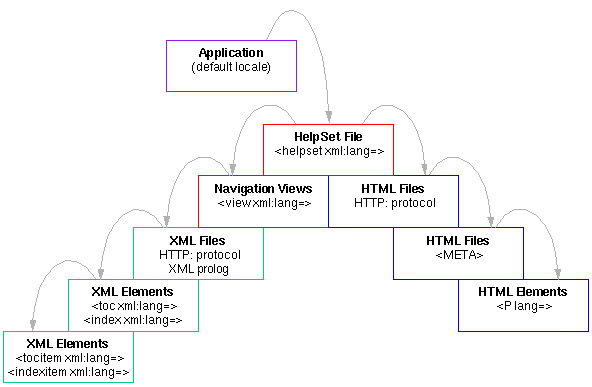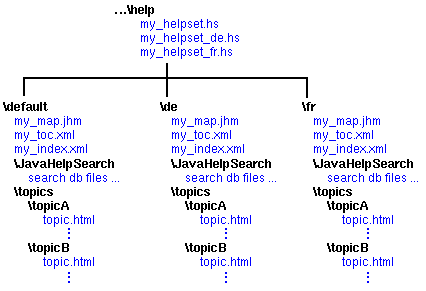
The portal to all JavaHelp system help information is the HelpSet file which defines the HelpSet. The HelpSet is the set of data that constitutes your help system and includes:
The following diagram shows the different levels in the JavaHelp system where the locale can be set and localization can occur, starting with the host application and moving into the HelpSet. Changes to locale are propagated down the hierarchy, with a change at each level overriding the locale set above it.

The locale of a HelpSet is usually set through the HelpSet
file. The locale for the entire HelpSet can be specified
through the HelpSet file, although portions of it can be be
selectively overridden in the data files.
When the application activates the JavaHelp system, the application uses the HelpSet.findHelpSet method to find the correct HelpSet file and return its location (URL). The full name of the HelpSet file is constructed based on the name of the HelpSet file specified as an argument to HelpSet.findHelpSet, and the locale based on either the system default locale or a locale specified as an optional argument. The name of the locale-specific HelpSet file is constructed and then searched for in the following order (from most to least specific):
![]()
The defaults are derived from the system using the
Locale.getDefault method.
The HelpSet file can be used to control the locale of different aspects of the help system. The XML language controls used to set locale are discussed in more detail in Localizing XML Data.
The xml:lang attribute can be used within the <helpset> tag to specify the locale of the entire HelpSet (the other elements in the HelpSet file automatically inherit the locale). For example:
<helpset xml:lang="fr">
The locale specified for the HelpSet in this manner
overrides any locale acquired from the system or the
application. For this reason, it is the most reliable means
for setting the HelpSet locale.
The locale of the <title> element is always the same as locale of the HelpSet. Any xml:lang attributes specified for the <title> element are ignored.
The xml:lang attribute can also be used to change the locale of the navigator views specified in the <view> elements (for example, the TOC and index). Note, however, that this locale is overridden by any locale settings specified by xml:lang attributes in the TOC and index XML definition files, as described in XML Data.
The locale of the <label> element is always
the same as the locale of the containing view. Any
xml:lang attributes specified for
<label> elements are ignored.
JavaHelp makes it possible to simultaneously distribute multiple localized HelpSets--for example, German, French, and English. As described above, the HelpSet.findHelpSet method determines the correct HelpSet file based on the system's locale or as set by the application using HelpBroker.setLocale(). You can include multiple, localized HelpSet files and locate the appropriate version using this naming convention.
If you ship multiple locales, you will probably organize your help information a little differently than is described in Setting Up a JavaHelp System. The following diagram shows one way you can organize the help information by locale:

Note that the paths specified in the <data> sections of the localized HelpSet files must point to the appropriate locations. For example:
<maps>
<mapref> location="de/Map.jhm" />
</maps>
<view>
<name>TOC</name>
<label>Holidays</label>
<type>javax.help.TOCView</type>
<data>de/HolidayTOC.xml</data>
</view>
JavaHelp system HelpSets can be merged. The locale of a HelpSet is
maintained in a merge operation. For instance, if the
master HelpSet (locale en_US) is merged with
another Helpset (locale fr_FR), the locale of both
HelpSets is maintained.
Map data should not be localized. If IDs (target attribute) are localized they will no longer match the IDs used internally in the application.
![]() See also:
See also: